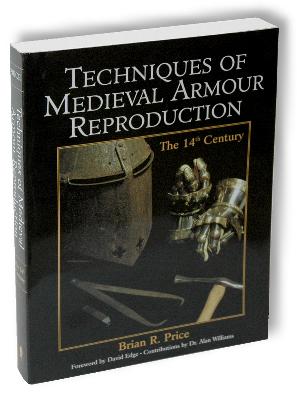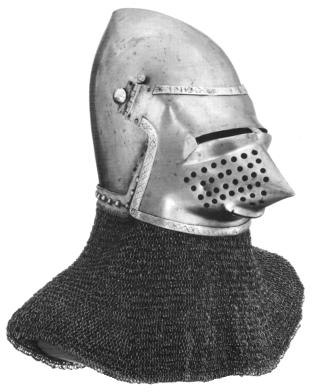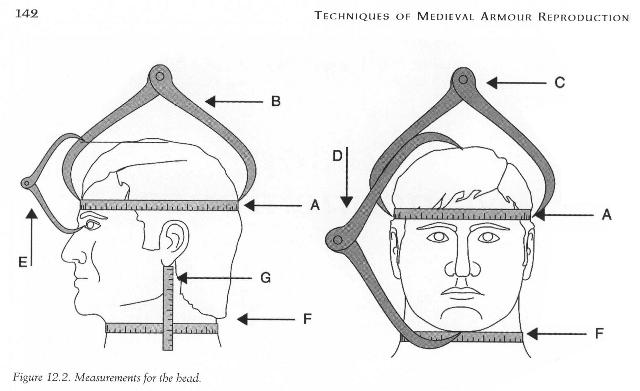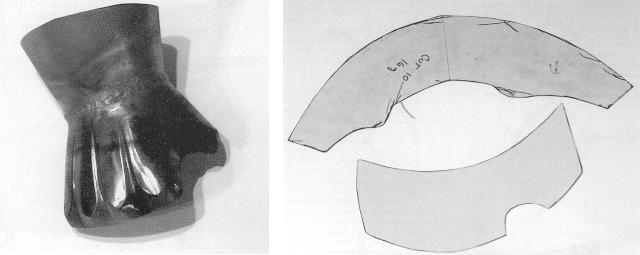|
|
|

|
Brian R. Price
Techniques of
Medieval Armour
Reproduction
The 14th Century
507 Pages, Softbound, B&W size 8-1/2 x 11"
|
Book Review by Jock Dempsey
Among modern Armourers this book is simply as "TOMAR", prounounced like it sounds.
In the short time since its publication it has become the bible of modern armor reproduction.
Thee are hundreds of clear photos and illustrations.

Throughout the book there are many excellent photos of both historical and reproduction pieces with annotations.
The piece to the left is an example.
Fig 1.6. A Milanese bascinet of the late 14th century.
Certainly Italian, and closely related to the famous exampleremaining at Churburg, it is one of the few bascinets where the helment an visor seem to match.
Weight with aventail: 1`5 pounds, 11 ounces.
Bequent of Sir Archibald Lyle, 1946, in memory of his sone Captain I.A. de H Lyle, Black Watch, killed at ALmain, November 1942,
and Major R.A. Lyle, Scottish Horse, killed at Normandy, June 1944.
From the armoury at Schloss Churburg; acquired in 1924 for the Mackay Collection; sold Christie's, July 1939, lot 70.
(Photo © Board of Trustees of the Royal Armouries, IV.470.)
The book starts with a discussion of the history of armour making centers and the difference between historical repairs, reproductions and weekend warrior armour such as for SCA use.
Design is discussed for everything from fantasy armour to museum quality reproductions.
Tools ranging from traditional stakes, anvils and hammers are discussed.
So are classic as well as modern shears and punches.
Besides metal working tools, measurement tools and leather working tools are also discussed.
Making ones own tools is discussed as well as purchasing.
 Measuring for helms and armour are is covered in detail, then making patterns, cutting and cleaning up sheet.
Then shaping and hammering, finishing and joining.
Articulated armour design and methods is covered in detail.
Measuring for helms and armour are is covered in detail, then making patterns, cutting and cleaning up sheet.
Then shaping and hammering, finishing and joining.
Articulated armour design and methods is covered in detail.
 Anyone with a strong interest in metalworking could learn to make armour from this book.
Those with a background in metal work will find good instruction in an unusual field as well as methods they may not have picked up elsewhere.
If someone was to develop a course in armour making this could be the text book.
Anyone with a strong interest in metalworking could learn to make armour from this book.
Those with a background in metal work will find good instruction in an unusual field as well as methods they may not have picked up elsewhere.
If someone was to develop a course in armour making this could be the text book.
Besides methods and step by step how to Price recommeds other references and serious research.
Among the resources listed are:
- Claude Blair's European Armour
- Paul Martin's Armour and Weapons
- Sir Guy Laking's Arms and Armour through Seven Centuries (rare 5 vol. set now in reprint)
- Lionello Boccia works on 15th ans 16th Century Itialian Armour.
- The Armourer and His Craft from the XIth to the XVIth Century.
- Books on museum collections and historic studies
(these come and go often only being printed once in a lifetime and must be purchased when the oportunity presents itself.
- Museums
- Periodicals
- The Internet.
To the above I would add Burk's General Armoury, the record of British coats of arms.
As many of these are emblazoned on armour one should know how to read and reconstruct the --- of the arms.
Published by: Pallidin Press
P.O. Box 1307
Boulder, CO 80306
USA
Published: 2000
ISBN 1-58160-098-4
$40.00 US
|
|
|
Techniques of
Medieval Armour
Reproduction
The 14th Century
507 Pages, Softbound, B&W size 8-1/2 x 11"
Book Review by Jock Dempsey
Among modern Armourers this book is simply as "TOMAR", prounounced like it sounds. In the short time since its publication it has become the bible of modern armor reproduction. Thee are hundreds of clear photos and illustrations.Throughout the book there are many excellent photos of both historical and reproduction pieces with annotations. The piece to the left is an example. The book starts with a discussion of the history of armour making centers and the difference between historical repairs, reproductions and weekend warrior armour such as for SCA use. Design is discussed for everything from fantasy armour to museum quality reproductions.
Tools ranging from traditional stakes, anvils and hammers are discussed. So are classic as well as modern shears and punches. Besides metal working tools, measurement tools and leather working tools are also discussed. Making ones own tools is discussed as well as purchasing.
Besides methods and step by step how to Price recommeds other references and serious research. Among the resources listed are:
- Claude Blair's European Armour
- Paul Martin's Armour and Weapons
- Sir Guy Laking's Arms and Armour through Seven Centuries (rare 5 vol. set now in reprint)
- Lionello Boccia works on 15th ans 16th Century Itialian Armour.
- The Armourer and His Craft from the XIth to the XVIth Century.
- Books on museum collections and historic studies
(these come and go often only being printed once in a lifetime and must be purchased when the oportunity presents itself.
- Museums
- Periodicals
- The Internet.
To the above I would add Burk's General Armoury, the record of British coats of arms. As many of these are emblazoned on armour one should know how to read and reconstruct the --- of the arms.Published by: Pallidin Press
P.O. Box 1307 Boulder, CO 80306
USA
ISBN 1-58160-098-4
$40.00 US